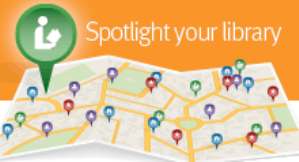 OCLC recently launched Library Spotlight, a new, free service that uses data from the WorldCat Registry to make it easier for users to find location and contact information for libraries using the web, and includes analytics tools to help libraries examine patron traffic trends or compare their collections and services to other libraries by location, local demographics, or other criteria. Online directory service Yelp is one of the first 3rd parties that has agreed to work with OCLC on the project to highlight library contact and services information.
OCLC recently launched Library Spotlight, a new, free service that uses data from the WorldCat Registry to make it easier for users to find location and contact information for libraries using the web, and includes analytics tools to help libraries examine patron traffic trends or compare their collections and services to other libraries by location, local demographics, or other criteria. Online directory service Yelp is one of the first 3rd parties that has agreed to work with OCLC on the project to highlight library contact and services information.
Although Library Spotlight draws basic data from the WorldCat registry, the program also enables libraries to use a single interface to add, edit, and update information about their library, including photos, the availability of services such as wifi, or links to social content or collections. OCLC will then use this information to populate multiple web destinations, including Yelp. In addition, the service will create a mobile-optimized link for each library, making the information easier to access and read on smartphones and tablets.
“As we talked with libraries about what kind of things were important to them—moving beyond collections to more the idea of the library as a place and a part of a community—they were very clear that mobile was a big priority,” Jeff Penka, OCLC director of global discovery and syndication, told LJ. OCLC research on smartphone use indicated that people using mobile devices to search for places on the web are generally looking for information such as ‘who is open nearby?’ ‘when are they open?’ and ’is this a good place to work?’” which would encompass services such as wifi, Penka explained.
Syndication and Visibility
Library Spotlight is the latest effort by OCLC to leverage the power of syndicated data to help their members make libraries and library services more visible on the web. In a presentation produced by OCLC and posted to YouTube earlier this month, the organization urges libraries to consider the connection between their role as a local information hub and their role within a growing network of other information hubs, as well the power syndication can have to raise a library’s profile in both scenarios.
Historically, radio was a good example of syndication, the presentation explains. A central content creator and distributor, such as CBS, developed and syndicated content for its affiliate stations, which then broadcast that content to their local audiences—an efficient top-down hub and node system. On the web, however, audience members are no longer passive consumers of information.
“Traditional library activities closely resemble syndication in both goals and patterns. Libraries have always served as hubs for local audiences, providing access to a variety of materials from many different sources. And people today still connect to libraries for materials and services, obviously. But they are increasingly doing so within personal information networks that they create, using a variety of other hubs based on their specific needs,” such as Google, Facebook, Goodreads, Amazon, and other sites, the presentation notes.
“By syndicating library location data across many such partners [via Library Spotlight], the goal is to make libraries as easy to find as local restaurants, hotels, and coffee shops,” Penka said.
Meanwhile, any unique information libraries can aggregate and distribute, such as information about local events, local news, training opportunities, special collections, curated content, or new library programs, could likewise be compelling to that local audience.


